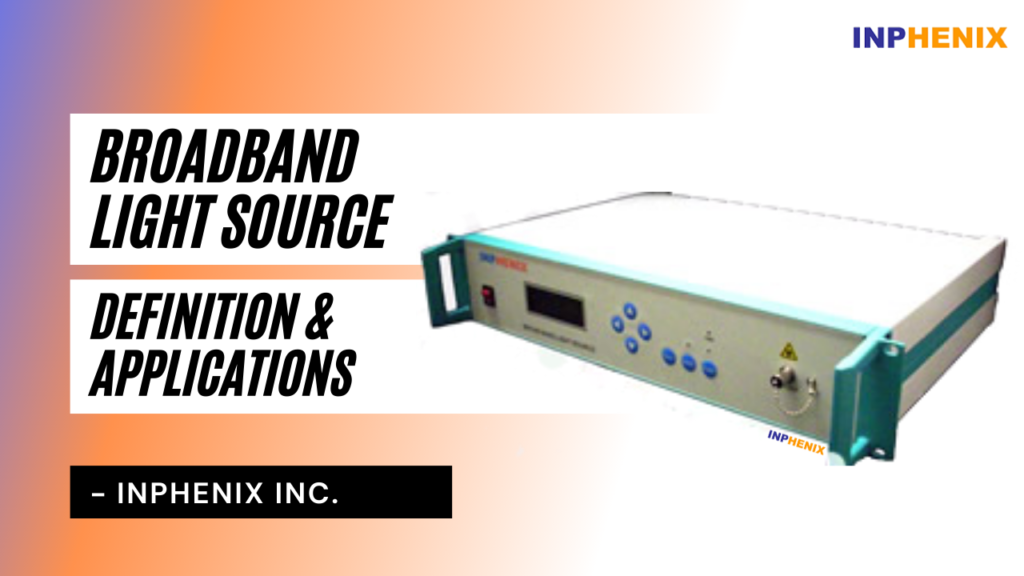
The 20th and 21st centuries were truly phenomenal for technological advances, particularly in the fields of light sources and laser manufacturing. During this period, we have been introduced to a variety of unique light products such as a broadband light source that has considerably enhanced the functioning of several other types of equipment used in various industries such as medicine, electronics, and forensics.
In this post, we will discuss a broadband light source. We’ll go over its fundamentals and look at some of its most important applications.

Simply put, broadband light sources are light sources that produce light across a wide range of wavelengths, as opposed to monochromatic light sources, which produce only a single wavelength or color of light. These light sources are extremely useful since they emit a wide range of light wavelengths. We may then use the monochromator to select the exact color we require for our application.
That is the fundamental introduction or definition of a broadband light source. Let’s move on to the next section to learn the applications of this light source.
The three principal applications of broadband light sources are as follows. Let’s take a quick look at each one to get a better understanding of them.
Broadband light sources are commonly used for optical pumping. Optical pumping is the use of light energy to elevate the atoms of a system from one energy level to another. To induce the transition among the levels, broadband or broad-spectrum is usually employed.
The most common light source used in optical pumping is a flashlamp. However, the range of performance of a flashlamp varies depending on the electrical input energy, lamp size, and light duration. Bottom line– a broadband light source is critical in optical pumping.
It is critical to identify biological evidence at the crime scene, such as blood, semen, saliva, and urine, in order to solve the case and reach a conclusion. This task, however, is difficult and cannot be performed using regular light sources. This is why we require special or unique light sources, such as broadband light sources.
Due to their characteristics, such as light absorption or fluorescence effect, biological evidence can be detected by forensic light sources. Furthermore, because the rate of detection of biological evidence by human observation varies, a computerized detection method using a camera and FLS would provide a more precise detection.
Ultraviolet spectroscopy is a technique that is commonly adopted in many scientific fields. To mention a few, these include drug identification, quality control in the beverage sector, and chemical research. This approach determines the number of distinct wavelengths of UV or visible light absorbed or transmitted by a material.
A single xenon lamp is typically utilized as a high-intensity light source for both UV and visible ranges. Likewise, for instruments with two lamps, a tungsten or halogen lamp is commonly employed for visible light. In addition, the instrument uses a monochromator to split the light into a small range of wavelengths.
Broadband light sources are indispensable in fiber optics, where they play a major role in optical communication. Fiber optics involves data transmission properties using light signals through optical fibers. Broadband light sources provide the necessary signals for efficient data transmission.
In simple words, broadband light sources are an essential part of the internet world. They emit light in various wavelengths, making sure our internet, videos, and calls work smoothly. The light signals sent carry all the data we need for our online stuff. So, thanks to these sources, our internet experience stays fast and reliable.
In fluorescence spectroscopy, a potent technique for examining materials, the sample is illuminated with light. The ensuing fluorescence offers crucial insights into the composition of the material. Broadband light sources, with their diverse wavelengths, empower researchers to stimulate a variety of fluorophores, enhancing the flexibility of fluorescence spectroscopy.
This enhanced flexibility in fluorescence spectroscopy positions it as an invaluable tool for scientific analysis. Whether scrutinizing biological samples or chemical compounds, broadband light sources play a pivotal role in the comprehensive examination of fluorescent materials.
In polarimeters, researchers use broadband light sources to offer a continuous spectrum of light that is selectively polarized. It enables researchers to study how substances interact with polarized light. Thereby, providing valuable insights into the composition and structure of materials.
From determining the concentration of a substance to exploring molecular structures, polarimeters powered by broadband light sources are instrumental in various scientific investigations.
In the medical field, broadband light sources find application in laparoscopy, a minimally invasive surgical technique. This technique enables surgeons to visualize internal organs on a screen by inserting a small camera into the body through a tiny incision, making procedures less invasive and more precise.
Broadband light sources provide bright and accurate illumination, enhancing the precision of surgical procedures while minimizing invasiveness. This application showcases the adaptability of broadband light sources in medical technologies, contributing to advancements in surgical practices.
The spectrophotometry technique allows scientists to measure how much a substance absorbs or lets light pass through at different wavelengths. Broadband light sources are critical components in spectrophotometry by providing a broad spectrum of light, allowing accurate analysis of the absorption and transmission characteristics of materials.
The technique dominates in various scientific disciplines, including chemistry, biology, and environmental science. Researchers rely on broadband light sources to unravel the optical properties of materials, contributing to a deeper understanding of their behavior.
Broadband light sources are crucial in biomedical imaging techniques such as optical coherence tomography (OCT). It is a renowned non-invasive imaging method with significance in medical diagnostics to capture detailed, high-resolution images of biological tissues.
These light sources provide the necessary illumination for imaging, allowing clinicians to visualize tissue structures with exceptional clarity. In healthcare, broadband light sources contribute to improved diagnostics and monitoring.
Hyperspectral imaging involves information capture and processing from across the electromagnetic spectrum. Broadband light sources contribute to this imaging technique by providing a wide range of wavelengths. This enables hyperspectral cameras to collect detailed spectral information for each pixel in an image, facilitating applications in remote sensing, agriculture, and geological studies.
From monitoring crop health to geological exploration, hyperspectral imaging powered by broadband light sources offers insights across diverse fields.
Inphenix is a US-based light source manufacturer that specializes in optical devices such as swept-source lasers, distributed feedback lasers, gain chips, Fabry Perot lasers, and VCSELs. Our products are cutting-edge, affordable, and integrated with a wide variety of devices.
